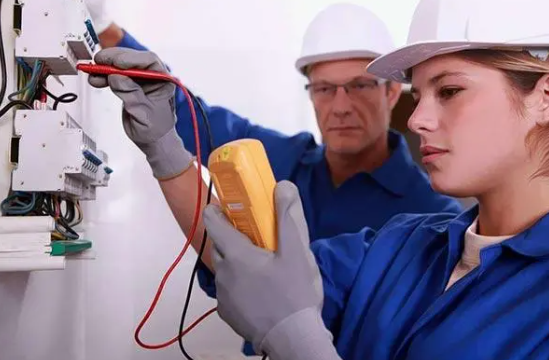I. Introduction to Multimeters
A. Definition of Multimeter
A multimeter is a magneto-electric instrument with a rectifier that can measure a variety of electrical parameters such as AC and DC current, voltage and resistance. For each electrical quantity, there are generally several ranges. Also known as a multi-meter or simply multi-meter. A multimeter consists of a magneto-electric ammeter (meter head), a measurement circuit, and a selector switch. By changing the selector switch, a variety of electrical parameters can be easily measured. The main basis for circuit calculation is the closed circuit Ohm's law. There are many types of multimeters, which should be selected according to different requirements.
General multimeter can measure DC current, DC voltage, AC voltage and resistance. Some multimeters can also measure capacitance, inductance, power, transistor co-emitter DC amplification factor hFE.
B. Typical uses of multimeters
There are many typical uses of multimeters in electronics and electrical engineering, including:
- measuring voltage: this is the most basic function of a multimeter and can be used to measure the voltage of a battery or power supply.
- Measuring current: A multimeter can be used to measure the current in a circuit to determine if the device is working properly.
- Measurement of resistance: Multimeters can be used to measure the resistance of resistors or to check the connectivity of wires and switches.
- Capacitance measurement: Some advanced multimeters can measure the capacitance of capacitors.
- Fault detection: Multimeters can be used to check circuits for shorts or breaks.
- Diode and transistor testing: Some multimeters have special settings to test these electronic components .
- Temperature measurement: Some advanced multimeters are equipped with thermocouples that can be used to measure temperature.
- Frequency measurements: Some multimeters can measure the frequency of an AC power source.
Overall, multimeters are very useful tools that can help engineers and technicians make all types of electrical and electronic measurements.
figure 1:typical use of multimeter
II. Understanding capacitance
Capacitance is a physical quantity that describes the ability of an object to store electrical charge. In electrical circuits, this is usually accomplished by capacitors, which can store and release electrical energy in response to changes in voltage.
The unit of capacitance is the farad, with common prefixes such as microfarads (μF), picofarads (pF), and nanofarads (nF).
The formula for capacitance is C=Q/V, where C is capacitance, Q is charge, and V is voltage. The meaning of this formula is that capacitance is equal to the charge stored on the capacitor divided by the voltage across the capacitor.
figure 2:A capacitance
III. Microfarads on Multimeters
A. Description of microfarad symbols
The symbol for microfarads on a multimeter is usually represented as 'uF', 'μF', or 'MFD'. The 'μ' is a Greek letter 'mu', which represents 'micro-' in the metric system, indicating a factor of one millionth (0.000001 or 10^-6). The 'F' stands for Farads, the unit for capacitance.
So when you see 'uF', 'μF', or 'MFD' on a multimeter, it refers to the measurement unit microfarads, which is used to measure capacitance.
B. How to locate and read the microfarad measurement on a multimeter
- Locate the correct setting on the multimeter: Multimeters usually have a dial or button that allows you to select the measurement you want. Look for the symbol for capacitance (usually represented as 'C' or 'CAP') or the microfarad symbol ('uF', 'μF', or 'MFD').
- Connect the probes: Connect the red probe to the 'VΩmA' or 'μF' port, and the black probe to the 'COM' port on the multimeter.
- Prepare the capacitor: Before measuring, make sure the capacitor is discharged. You can do this by connecting the capacitor's leads with resistor for a few moments.
- Connect the probes to the capacitor: Connect the red (positive) probe to the positive side of the capacitor, and the black (negative) probe to the negative side.
- Read the measurement: The display on the multimeter will show the capacitance of the capacitor in microfarads.
Remember, always follow the safety instructions provided with your multimeter to avoid any potential hazards while measuring.
IV. How to use a multimeter to measure Microfarads
A. Step-by-step guide to using a multimeter for this purpose
- Select the multimeter to the smallest range and choose the appropriate measuring range according to the current or voltage to be measured.
- Make reasonable wiring for the circuit to be measured. When the current is to be measured, adjust the current setting of the multimeter to the appropriate setting, and then connect the measuring terminal A of the multimeter to the positive terminal of the circuit to be measured, and the wiring clamp or wire clips to port B with micrometer resistance.
- According to the range of the multimeter and the circuit to be tested to select the appropriate micrometer resistance, you can generally choose to use the multimeter under the minimum range of x1 or x10 multiples.
- Connect the selected micrometer resistance with port B.
5. Open the circuit to be tested, use the multimeter to directly read the measured value of the two ends of the micrometer resistance, and note that the range of the multimeter is converted to the actual value of the circuit.
B. Safety Precautions When Using Multimeter
1. "Mechanical zeroing" before use
Mechanical zeroing refers to adjusting the hairspring of the meter head without power supply to make the pointer point to zero.
Before using the multimeter, you should first observe whether the multimeter's pointer is aligned with the zero scale line on the left side, if it is not aligned, you should carry out the "mechanical zeroing", otherwise it will affect the readings and lead to inaccurate measurement results.
2. Strictly prohibit the use of hands touching the metal part of the meter pen.
The use of multimeter needs to be connected with the pen, it is strictly prohibited to touch the metal part of the pen, which will not only affect the measurement results, but also may cause electric shock.
3. Prohibit switching gears during measurement
When measuring circuit current and voltage, it is forbidden to switch gears at the same time, otherwise it is easy to damage the multimeter. Especially when measuring high voltage and high current, switching gears can easily generate arcs, which may burn the switch contacts and is very dangerous. To switch gears, you should first remove the meter pen, and then switch gears, and then measure after changing.
4. Gear selection should be from large to small
When you are not sure about the size of the measured current or voltage, you should choose the highest grade first, and then adjust to the appropriate grade according to the measurement result, so as to avoid the needle deflection too big to bend the needle or damage the meter head.
5. Use the multimeter should be placed horizontally.
When using the multimeter, it should be placed in a flat position, horizontally, and the reading should be right on the dial, so as not to cause errors.
6. Don't connect the positive and negative poles wrongly
When measuring DC current or DC voltage, pay attention to the positive and negative poles not to be connected inversely, otherwise the needle will rotate in the opposite direction. Once the positive and negative poles are reversed, the red and black pens should be turned immediately to avoid damage to the meter needle, head and other parts.
ALSO READ:Convert nF to μF (Nanofarad to Microfarad)
V. Conclusion
The use of multimeters for micrometry measurements can improve the accuracy and resolution of the measurements, and is suitable for some occasions that require high accuracy of current and voltage. When performing micrometry measurements, it is necessary to pay attention to the calibration of the multimeter and select the appropriate measurement range, as well as the correct wiring and avoiding circuit failures to ensure the accuracy of the measurement results.
Useful video:
How to read microfarads on your meter





